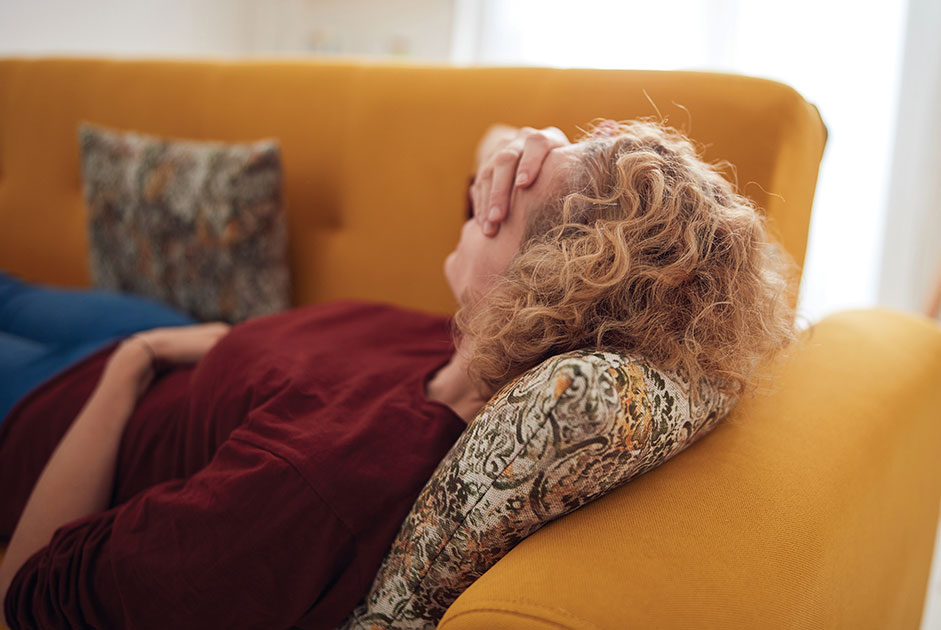One in four women has had a migraine headache. In fact, the debilitating headaches affect three times more women than men. In the United States, over 37 million men, women, and children suffer from migraine, but fewer than five percent of those affected have been accurately diagnosed or are receiving appropriate care.
Some of the most common types of headaches include:
-
Tension headaches: Pain from a tension headache generally spreads across the forehead, or it might start at the back of the neck and move forward. This is the most common type of headache. Things that can cause tension headaches include stress, hunger, or eye strain.
-
Sinus headaches: These headaches often appear when you are congested or feeling unwell. They are caused by swelling in the sinus passages, which causes pain behind the nose, cheeks, eyes, and forehead.
-
Cluster headaches: Like migraines, these headaches are usually very painful and come in “clusters,” which means they occur daily (often at the same time of day) and can sometimes last for several days or even months. Like migraines, they are caused by the dilation of blood vessels in the brain due to a release of serotonin and histamines. They can be caused by physical exertion, bright lights, heat, or even altitude.
-
Migraine headaches: A migraine is more than a simple headache. It is a neurological condition, which involves nerve pathways and chemicals. Changes in brain activity affect blood in the brain and surrounding tissues which can cause any or all the following symptoms: intense pain, nausea, dizziness, fatigue, and sensitivity to light, sounds, or smells. Migraine sufferers often describe a throbbing or pulsing pain behind one eye.
There is no one cause for migraine and the triggers can differ from one person to another. Triggers can include:
-
Hormonal changes: Many women experience more frequent or worse migraines when they have their menstrual cycle.
-
Allergies: Allergies cause irritation and inflammation in the body. Because migraines are associated with inflammation of the blood vessels, allergies are a known trigger for some people.
-
Genetics: Those with family members who suffer from migraines are more likely to develop migraines themselves. Scientists have discovered a genetic mutation that is common in people with the most typical type of migraine.
-
Environmental: This can include a wide variety of triggers. Changes in weather, stress, food, smells, and lack of sleep.
Keeping a migraine journal can help you track patterns and identify triggers. It’s especially important to note things like the time of day your migraine began, what you were doing, and where you were. What were your surroundings like? Indoors, outdoors? What was the weather like? Did you eat or drink anything? Also note how long the pain lasted.
This information can help you and your physician create a plan to avoid your triggers and reduce the frequency of your migraines.
Treatment for Migraines: There is no one size fits all cure for migraine, but combinations of medications and lifestyle changes may help treat symptoms and decrease severity of or prevent future episodes.
Over the Counter Medication
Over the counter pain medicines like acetaminophen, ibuprofen and aspirin can be helpful for headaches or mild migraines. Some migraine sufferers find relief with Excedrin® Migraine and some are helped by drinking something with caffeine.
Prescription Medications & Lifestyle Changes
Prescription medication may be indicated if you suffer from frequent migraines that are disrupting your life. Combined with lifestyle changes, migraine sufferers may find relief, but some trial and error will most likely be required.
Some medications that have proven to be helpful:
-
Blood pressure medicines, such as beta blockers
-
Tricyclic Antidepressants, such as Elavil (amitriptyline) or Pamelor (nortriptyline)
-
Anti-seizure medicines, such as Topamax (topiramate)
-
Botulinum toxin A (Botox) injections
-
Triptans, like Imitrex (sumatriptan)
-
Monoclonal antibody drugs, like Aimovig (erenumab-aooe)
Lifestyle Changes that may help:
-
Exercising regularly
-
Dietary changes to avoid trigger foods (including dark chocolate, cured meats, aged cheeses, wine or pickled or fermented items)
-
Going to sleep and waking at the same time every day
-
Relaxation techniques, like yoga and meditation
-
Avoiding bright lights or too much screen time
-
Staying out of extreme heat or cold
When to seek immediate help:
-
Sudden, very intense headache pain
-
Severe or sharp headache pain for the first time
-
A stiff neck and fever
-
A fever higher than 102 to 104°F
-
Nausea and vomiting
-
Nosebleed that doesn’t stop
-
Fainting
-
Dizziness or loss of balance
Migraines can be widely misunderstood and because the person suffering doesn’t “look” ill, their pain may not be taken seriously. If you or someone you love is experiencing signs or symptoms of migraine, it’s important to find a doctor who will take your concerns seriously and treat you with compassion. You can also seek out support online where there are groups of other sufferers who offer their own stories and provide a place to ask questions.






















